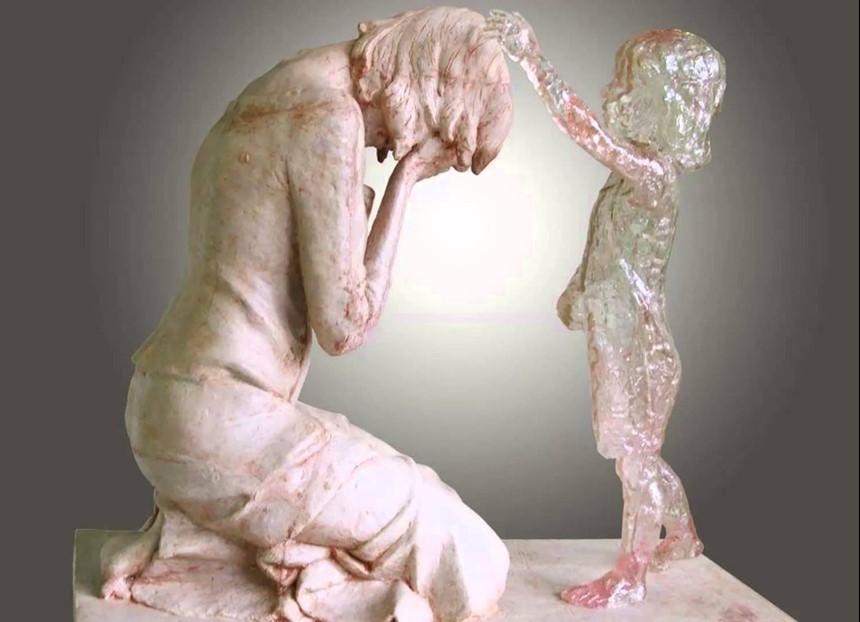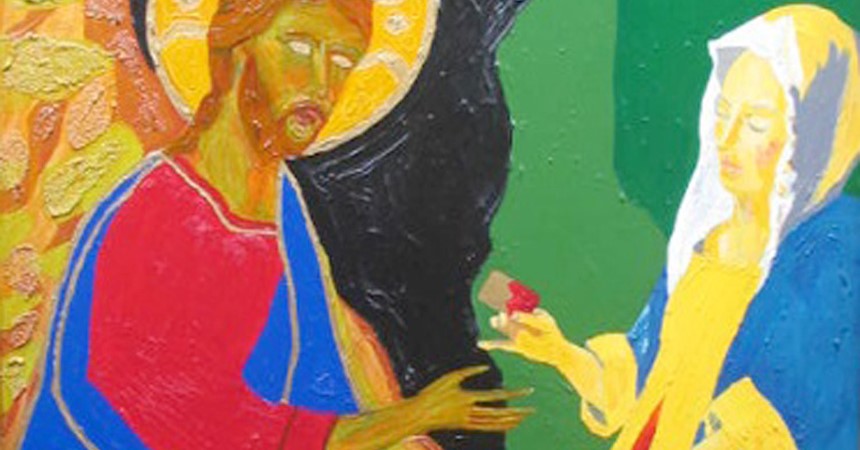If I were to ask you to associate a work of art with the theme of ‘mercy’, which one would you nominate?
You might opt for a perennial favourite – Picasso’s “Weeping woman”; Rembrandt’s “Prodigal Son”; Goya’s “The Third of May 1808”; Van Gogh’s “Self-portrait with bandaged ear”; Sieger Köder’s “Home – the invitation poster” or even William Etty’s “Mercy interceding for the Vanquished”. (See endnotes[i]).
I want to explore what art can teach us about mercy. I will focus here on Martin Hudáček’s sculpture, “Memorial for unborn children” and my own painting, “Jesus cures the woman with the flow of cash”.
The Child Who Was Never Born/Memorial for Unborn Children (2010)

As an art student, Slovakian Martin Hudáček created a sculpture to draw attention to the devastation abortion can bring to a woman, and to the fact that through the love and mercy of God, reconciliation and healing are possible.
The sculpture (used with permission)[ii] shows a woman in great sorrow grieving her abortion. The second figure in the work is the aborted child, a young girl, who comes to the mother to offer forgiveness. The work does not adopt a moral position concerning abortion – it simply endeavours to show the viewer the aftermath of the event, the responses of mother and potential child, and the mercy shown by God through the child. Remnants of red in both figures perhaps demonstrate the suffering associated with such a traumatic event and possibly link the narrative with the passion of Christ.
Hudáček has noted that the sculpture also, “expresses hope which is given to believers by the One who died on the cross for us, and showed how much He cares about all of us.”[iii] In like manner, Pope Francis has called the Church to be an “oasis of mercy” in a wounded and violent world. He prefers to understand ‘mercy’ as ‘mercy-ing’, an ongoing and active outreach to others.[iv] This too, I believe, is what this sculpture is attempting to communicate.
In addition, this work reflects the complex and multifaceted nature of mercy. In the eyes of G Simon Harak, mercy is a constellation of attitudes and practices ranging from contrition and forgiveness to reconciliation. However, mercy differs in one important respect from forgiveness in that it is always a one-way communication from One to another.
It also involves the dimension of judgement whereby the judge or superior releases the wrongdoer from punishment and thus exercises mercy – as well as some awareness that God is the primary locus of mercy. As Harak states, “…even without specific reference to their sin, God must have mercy toward creatures so…they can continue to live in God’s presence. In short, ‘What God has created, God’s mercy sustains’”.[v] In terms of Hudáček’s sculpture, it could be said that the woman kneels in judgement but is released by the mercy of God, personified by the child’s gesture of forgiveness fused with blessing.
Jesus cures the woman with the flow of cash (Peter Mudge, 2005)
The second painting is held by the Episcopal parish of Atlanta, Georgia, and is often used as an exemplar in sermons.
The painting uses some background images and colours derived from the design of icons such as the mountain behind the figure of Christ. The Christ figure is taken from a Duccio (di Buoninsegna) painting, “The calling of the apostles Peter and Andrew” (c.1308-1311). The image of the woman on the left has been extracted from Jan Vermeer’s “Woman holding a balance” (Woman weighing gold) (c. 1664). She also references another biblical woman with a flow of blood, a pagan and outsider, afterwards cured by Jesus (Mark 5:25-34). Jesus is gesturing towards the woman who holds a credit card, stained with blood as is her inner tunic.
Adopting the techniques of Vermeer, Caravaggio and others, the painting captures the ‘action’ at a critical time. Is the woman handing over the credit card to Jesus or is she thinking better of her decision and ‘withdrawing’ it? The gold on the left of the card seems to indicate she is relinquishing one of her prized possessions, and its links to consumerism and possessiveness. Jesus gestures with compassion and mercy. The woman touches a small table, a detail from Andrei Rublev’s “Trinity” (1411 or 1425-27) which acts as a threshold. The table is marked by five red wounds referring to the passion of Christ (also shared by the woman?). A dark shadow on the woman’s veil looks like a hand.
Read the abovementioned passage from Mark, look at the painting, focus on mercy, and come up with your own interpretations. I sometimes ask people to propose speech bubbles for Jesus, the woman, the card, the table, the mountain. What is Jesus saying with respect to mercy? How does the woman respond – what type of cure is she requesting?
This painting, like the previous sculpture, returns us to one of the fundamental meanings of mercy – and one linked to our own ethical behaviour as well as the attributes of the God of Mercy. Mercy at its most basic level refers to that mildness or tenderness of heart which disposes a person to overlook injuries. It looks for the very best a person can be and treats him or her better than they would otherwise be treated. Mercy is tempered by justice and forgives all. It implies benevolence, tenderness, mildness, pity, compassion, justice and clemency.[vi]
Freud has famously noted, “The artists get there first”[vii] – they ‘see’ reality most truly before others do. The associations between art and mercy discussed in terms of these works would appear to support Freud.
Finally, as Cardinal Angelo Bagnasco has observed, “Justice and mercy either go hand in hand, each preparing the steps of the other, or they both limp along, groping in the fog.”[viii] Without the lens of art, as one important tool revealing the depths of mercy, we too might limp and grope through the fog, instead of walking upright by the light of a merciful God.
Dr Peter Mudge is Senior Lecturer in Religious Education and Spirituality at The Broken Bay Institute, Pennant Hills and Conjoint Lecturer, School of Humanities and Social Science, The University of Newcastle. He teaches religious education, theory and practice, and spirituality – traditions, practices and values. He has written an online course on the study of religious traditions to assist teachers of HSC Studies of Religion. He practises art in his home studio. Read a longer version of this article online.
[i] Websites on which you can view some of these images, all retrieved on 7/03/16: Picasso’s “The weeping woman”, www.pablopicasso.org/the-weeping-woman.jsp ; Rembrandt’s “Prodigal Son”, https://en.wikipedia.org/wiki/The_Return_of_the_Prodigal_Son_(Rembrandt) ; Goya’s “The Third of May 1808”, www.allposters.com/-sp/The-Third-of-May-1808-Painted-in-1814-Posters_i2589493_.htm ; Van Gogh’s “Self-portrait with bandaged ear”, https://commons.wikimedia.org/wiki/File:Vincent_van_Gogh_-_Self-portrait_with_bandaged_ear_(1889,_Courtauld_Institute).jpg ; Sieger Köder, “Jubilee of mercy – roller banner”, at www.paulineuk.org/browse/visual-resources/posters/sieger-koder/item/jubilee-of-mercy-roller-banner/5031446734964; and William Etty, “Mercy interceding for the Vanquished”, www.wikigallery.org/wiki/painting_214031/William-Etty/Mercy-interceding-for-the-Vanquished ;
[ii] The image reproduced here is discussed at the LifeSiteNews.com site, April 2, 2012. It can be located at www.lifesitenews.com/news/heart-rending-young-slovakian-sculptor-captures-post-abortion-pain-mercy-an The home page of the artist is at http://martinhudacek.sk/gallery.html
[iii] See previous note.
[iv] For both quotes and ideas refer to Andreas Batlogg & Daniel Izuzquiza. (2015). A merciful Church for a wounded world. Thinking Faith. 4 December 2015, p. 1.
[v] G. Simon Harak. (2007). Mercy. In Orlando O. Espín & James B. Nickoloff (eds.). An Introductory Dictionary of Theology and Religious Studies. Collegeville, MN: Liturgical Press, pp. 856-857.
[vi] Based on the King James Version Dictionary definition of ‘mercy’. Retrieved on 21/3/16 from http://av1611.com/kjbp/kjv-dictionary/merciful.html
[vii] Quoted in Steven Garber. (2010). Visions of vocation: Common grace for the common good. New York: InterVarsity Press; p. 69. Originally cited by Sigmund Freud.
[viii] Cardinal Angelo Bagnasco. (2009). Justice and Mercy. L’Osservatore Romano. 14 January 2009, p. 13.























































































